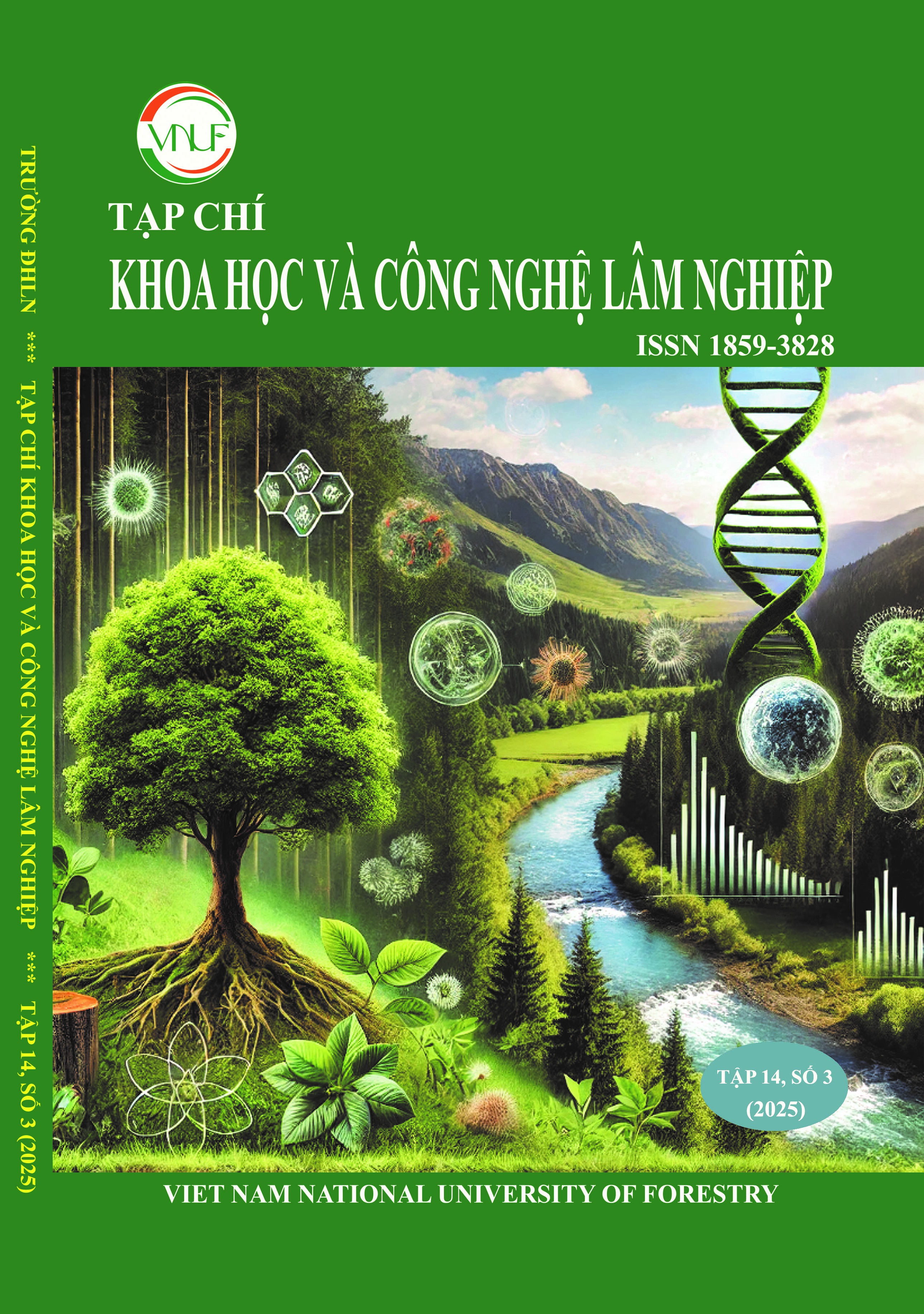Hiệu quả của kỹ thuật nuôi cấy mô trong chọn lọc giống lúa chống chịu mặn thông qua giai đoạn Callus
DOI:
https://doi.org/10.55250/Jo.vnuf.14.3.2025.042-051Từ khóa:
Invitro, Na+/K+ , QTL Saltol, SSRsTóm tắt
Kỹ thuật nuôi cấy mô (in-vitro) ngoài việc sử dụng để nhân giống vô tính ở thực vật, kỹ thuật này còn được sử dụng trong nhiều nghiên cứu khác như được dùng để đánh giá khả năng chống chịu với điều kiện bất lợi của môi trường. Dựa vào cơ sở khoa học trên, nghiên cứu này đã đánh giá khả năng chịu mặn của các giống lúa thông qua nuôi cấy trên môi trường nuôi cấy mô với các nồng độ khác nhau của muối Natri Clorua (NaCl). Callus của các giống được thử nghiệm trên môi trường MS với các nồng độ của NaCl: 0; 0,5; 1,0; 1,5; 2,0 g/L từ đó đánh giá được khả năng hấp thụ ion Na+ và K+ cũng như khả năng phát triển của callus trên môi trường stress mặn. Kết quả phân tích cho thấy tỷ lệ tích luỹ hàm lượng ion Na+/K+ của giống Đốc Phụng là thấp nhất và cao nhất là giống IR29 cũng tương tự với hàm lượng proline. Ngoài ra, việc sử dụng chỉ thị phân tử SSR với 18 maker liên kết với QTL chịu mặn cho thấy kết quả ở giống Đốc Phụng, FL478, Trà Lòng có mang kiểu gen chống chịu với giống với Pokkali và khác biệt hoàn toàn với giống mẫn cảm là IR29. Kết quả này cho thấy kỹ thuật nuôi cấy mô và marker SSRs có thể dùng để thanh lọc khả năng chịu mặn ở các giống lúa.
Tài liệu tham khảo
. M. Thomson, D. Ocampo, M. Egdane, J. Rahman, M. Sajise, A. Adorada, & M. Ismail. (2010). Characterizing the Saltol quantitative trait locus for salinity tolerance in rice. Rice. 3: 148-160.
. C. Hu, L. Gu, Z. Luan, J. Song, & K. Zhu (2012). Effects of montmorillonite–zinc oxide hybrid on performance, diarrhea, intestinal permeability and morphology of weanling pigs. Animal Feed Science and Technology. 177(1-2): 108-115.
. J. Shavindra & M. Amitabh (2005). Advanced in rice biotechnology in the new millennium, Plant Biotechnology Journal. 3: 275-307.
. E. Blumwald, G. S. Aharon, & M. P. Apse (2000). Sodium transport in plant cells. Biochimica et Biophysica Acta (BBA)-Biomembranes. 1465(1-2): 140-151.
. M. Nabors & T. Dykes (1985). Tissue culture of cereal cultivars with increased salt, drought and acid tolerance. Biotechnology in international agricultural research. 121-138.
. C. Sahi, A. Singh, K. Kumar, E. Blumwald & A. Grover (2006). Salt stress response in rice: genetics, molecular biology, and comparative genomics. Functional & integrative genomics, vol. 6, pp. 263-284.
. A. Priya, S. Pandian & M. Ramesh (2011). Effect of NaCl on in vitro plant regeneration from embryogenic callus cultures of'cv IR 64'indica rice (Oryza sativa L.). African Journal of Biotechnology. 10(36): 6947-6953.
. D. Galson & S. Mueller (1986). An introduction to the European Geotraverse Project: first results and present plans. Tectonophysics. 126(1): 1-30.
. F. Hauser & T. Horie (2010). A conserved primary salt tolerance mechanism mediated by HKT transporters: a mechanism for sodium exclusion and maintenance of high K+/Na+ ratio in leaves during salinity stress. Plant, cell & environment. 33(4): 552-565.
. L. Zeng & M. C. Shannon (2000). Salinity effects on seedling growth and yield components of rice. Crop science. 40(4): 996-1003.
. T. Murashige (1974). Plant propagation through tissue cultures. Annual review of plant physiology. 25(1): 135-166.
. R. Pushpam & S. Rangasamy (2000). Variations in chlorophyll contents of rice in relation to salinity. Crop Research. 20: 197-200
. K. Iseki, Y. Takahashi, C. Muto, K. Naito, & N. Tomooka (2018). Diversity of drought tolerance in the genus Vigna. Frontiers in Plant Science. 9: 729.
. J. J. Doyle (1990). Isolation of plant DNA from fresh tissue. Focus. 12: 13-15.
. K. Mullis, F. Ferre & R. Gibb (1998). Rapid Cycle DNA Amplification In, The polymerase chain reaction. Springer.
. S. Muhammad, T. Müller & R. G. Joergensen (2007). Compost and P amendments for stimulating microorganisms and maize growth in a saline soil from Pakistan in comparison with a nonsaline soil from Germany. Journal of Plant Nutrition and Soil Science. 170(6): 745-752.
. P. Shanthi, S. Jebaraj & S. Geetha (2010). In vitro screening for salt tolerance in Rice (Oryza sativa). Electronic Journal of plant breeding. 1(4): 1208-1212.
. S. Revathi & M. A. Pillai (2015). Novel approach in screening rice genotype for tolerance to salt stress under hydroponic culturE. Agricultural Science Digest-A Research Journal. 35(4): 308-310.
. R. Tyagi, A. Yusuf, P. Dua & A. Agrawal (2004). In vitro plant regeneration and genotype conservation of eight wild species of Curcuma. Biologia Plantarum. 48: 129-132.









